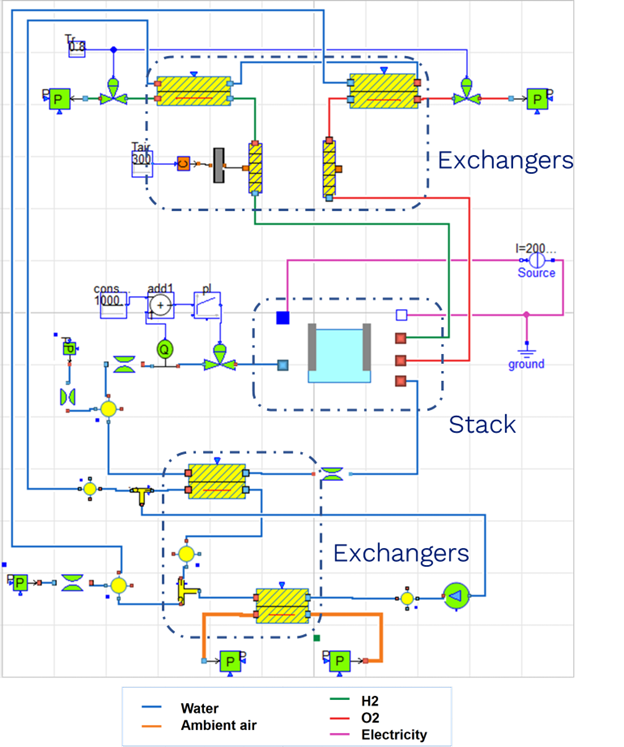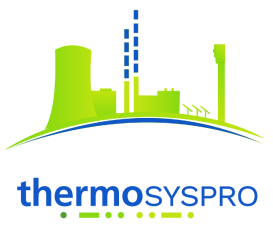Newsletter 2024
16/07/2024
Modelling a Hybrid Energy System
The Euratom TANDEM project has just released the homonymous open-source modelling library. Developed in the Modelica language by CEA, EDF, Polimi and Tractebel, it enables studying operating transients of complex energy systems powered by a cogenerative SMR (Small Modular Reactor). The objective is to ease their implementation and, finally, to contribute to a carbon-free Europe.
Available modelling bricks include District Heating, High Temperature Steam Electrolyser, Heat Storage…. The TANDEM library is based on a set of supporting libraries, among which ThermoSysPro, of course!

A Digital Twin of the secondary circuit chemistry
The monitoring of the secondary circuit chemistry is generally constrained by the limited sampling of on site measurements. Focusing on chemicals advection and pH computation, a digital twin to be used for the nuclear French fleet is under development: it couples the thermohydraulic bricks provided by ThermoSysPro with some water chemistry laws to provide an online and circuit-wide view. A first partial validation was succesfully run at the end of 2023 on the basis of historical experimental campaigns. This comparison was also valuable to validate the roadmap of further developments, for example to take into account thermal degradation of chemicals, or their absorption in resines….
Hydrogen Demo
Following first developments in 2022, a prototype of an electrolyzer model has been built in 2023, in partnership between EDF Lab Chatou and EIFER. The objective was to demonstrate the added value of a digital twin to challenge the suppliers and to better understand the dynamic behavior of a H2 production plant, especially when fed by renewable energy. This model consists of a simplified stack (PEM) and its auxiliary systems (pumps, exchangers, valves, control, etc.). Several fluids are modeled: water, air, H2 and O2. The initial results obtained are encouraging and have led to further work this year for EDF entities for the realization of hydrogen production plants that will be recalibrated on experimental data.
Details on the published H2 extension: here
.
Passive thermal conditionning of industrial premises
The thermal conditioning of premises housing thermo-sensitive equipment such as electrical or control cabinets is essential to ensure the proper functioning of installations in various operating scenarios, including normal ventilation operation or total or partial loss. Passive conditioning systems are studied using the building blocks provided by the TAeZoSysPro library, with relative efficiencies quantified through sensitivity analyses involving coupling Modelica models with the OpenTURNS python library. These preliminary studies have identified the most promising passive conditioning system, based on a thermosiphon loop with an ice tray. An experimental facility implementing this concept is currently under construction at EDF R&D to validate the developed models and help propose industrial sizing.
--- Quick Hits ---
ThermoSysPro and TAeZoSysPro moved on GitLab! Mail us to have your account created and interact with the team.
First advanced training session on ThermoSysPro on November 14th and 15th.
See you on October 11th for the ThermoSysPro User’s Club, the first one open to the world. Stay tuned!
Down the Rabbit Hole: our recent publications
Convection of Chemicals and Other Substances with ThermoSysPro G. Simonini, A. Duval, S. Hocine-Rastic, M. Praud
Modeling and Simulation of the Hydrogen Value Chain with ThermoSysPro and Modelica S. Vallejo Jimenez, L. Corona, D. Faille, D. Irofti
Integrating Small Modular Reactors into Hybrid Energy Systems: the TANDEM Modelica library G. Simonini et al.
Phase Changing Materials for temperature control in an industrial electronic room B. Ballot-Miguet, P. Borel, M. Houvin
Etude numérique thermo-aéraulique d’un local équipé d’une armoire électrique thermosensible : Analyse de sensibilité R. Moulouel, M. Abadie, P. Salagnac, P. Borel, Et M. Houvin
French version
Modélisation d'un système énergétique hybride
The Euratom TANDEM project has just released the homonymous open-source modelling library. Developed in the Modelica language by CEA, EDF, Polimi and Tractebel, it enables studying operating transients of complex energy systems powered by a cogenerative SMR (Small Modular Reactor). The objective is to ease their implementation and, finally, to contribute to a carbon-free Europe.
Available modelling bricks include District Heating, High Temperature Steam Electrolyser, Heat Storage…. The TANDEM library is based on a set of supporting libraries, among which ThermoSysPro, of course!

Jumeau numérique de la chimie du circuit secondaire
La surveillance de la chimie du circuit secondaire est généralement contrainte par un échantillonnage limité de mesures effectuées sur site. Axé sur le transport des produits chimiques et le calcul du pH, un jumeau numérique destiné au parc nucléaire français est en cours de développement : en couplant les briques thermohydrauliques fournies par ThermoSysPro avec des lois de chimie de l'eau, il donne accès à une vue globale du circuit et en continu. Une première validation partielle a été réalisée avec succès à fin 2023, sur la base de campagnes expérimentales historiques. Cette comparaison a également permis de valider la roadmap des développements à venir, par exemple pour prendre en compte la dégradation thermique des produits chimiques ou leur absorption dans les résines….
Démonstrateur hydrogène
A la suite de premiers développements réalisés en 2022, le prototype d’un modèle d’électrolyseur a été réalisé en 2023 en collaboration avec EDF Lab Chatou et EIFER. L’objectif était de montrer l’intérêt d’un jumeau numérique pour challenger les fournisseurs et mieux anticiper le comportement dynamique de stations de production d’H2 en particulier lorsqu’elles sont alimentées par des énergies renouvelables. Ce modèle est composé d’un stack simplifié (PEM) et de systèmes auxiliaires (pompes, échangeurs, vannes, régulation …). Plusieurs fluides sont modélisés : eau, air, H2 et O2. Les premiers résultats obtenus sont encourageants et ont conduit à la poursuite de travaux cette année pour des entités EDF pour la réalisation de modèles de centrales de production d’hydrogène recalées sur des données expérimentales.
Détails sur l’extension H2 de ThermoSysPro publiée : ici
.
Systèmes de conditionnement thermique industriels
Le conditionnement thermique des locaux abritant du matériel thermo-sensible comme des armoires électriques ou de contrôle commande est indispensable pour assurer le bon fonctionnement des installations dans les différentes situations de fonctionnement normal de la ventilation ou de sa perte totale ou partielle. Des systèmes de conditionnement passifs sont étudiés à l’aide des briques proposées par la bibliothèque TAeZoSysPro dont les efficacités relatives sont quantifiées à l’aide d’étude de sensibilité réalisées en couplant les modèles avec les outils de la bibliothèque python OpenTURNS. Ces études préliminaires ont permis d’identifier le système de conditionnement passif le plus prometteur, fondé sur une boucle passive par thermosiphon avec un bac à glace. Un laboratoire mettant en œuvre ce concept est en cours de construction chez EDF R&D afin de valider les modèles réalisés et proposer des règles de dimensionnement industrielles.
--- Vite lu ---
ThermoSysPro et TAeZoSysPro sont désormais disponibles sur GitLab ! Ecrivez-nous pour avoir un compte et interagir avec l’équipe.
La première session de la nouvelle formation ThermoSysPro avancée aura lieu le 14-15 novembre.
On se retrouve le 11 octobre pour le Club Utilisateurs de ThermoSysPro ? Le premier ouvert à tous ! À vos agendas !
Pour aller plus loin : les publications récentes de l’équipe
Convection of Chemicals and Other Substances with ThermoSysPro G. Simonini, A. Duval, S. Hocine-Rastic, M. Praud
Modeling and Simulation of the Hydrogen Value Chain with ThermoSysPro and Modelica S. Vallejo Jimenez, L. Corona, D. Faille, D. Irofti
Integrating Small Modular Reactors into Hybrid Energy Systems: the TANDEM Modelica library G. Simonini et al.
Phase Changing Materials for temperature control in an industrial electronic room B. Ballot-Miguet, P. Borel, M. Houvin
Etude numérique thermo-aéraulique d’un local équipé d’une armoire électrique thermosensible : Analyse de sensibilité R. Moulouel, M. Abadie, P. Salagnac, P. Borel, Et M. Houvin
